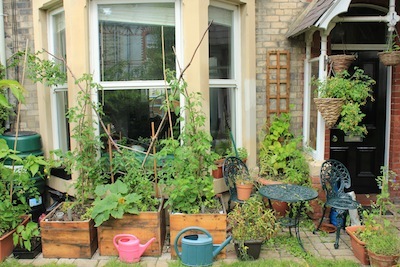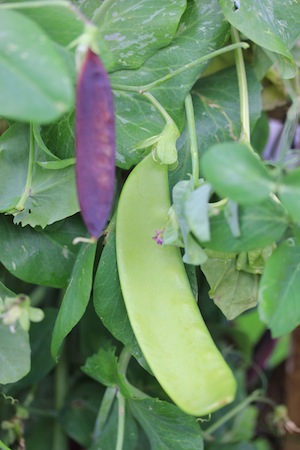Six lessons from a difficult growing year
 On June 28th Newcastle had the heaviest rain most people who live hear have ever seen. Here's a pot just after the deluge. This is a fast draining growing mix (with loads of holes in the base of the container) - so you can imagine how much rain fell!
On June 28th Newcastle had the heaviest rain most people who live hear have ever seen. Here's a pot just after the deluge. This is a fast draining growing mix (with loads of holes in the base of the container) - so you can imagine how much rain fell!If you've had a difficult year trying to grow food, you're not alone. In the UK, low light levels and a cold, wet summer have made it one of the worst growing years for decades. For those of you growing in other parts of the world, you may have experienced even more difficult challenges. If you're new to growing and you're dispirited by how difficult it's been - please don't give up. Growing is much easier and more rewarding when the weather is a little kinder. I promise.
My own growing year has been challenging, too. The tomatoes got early blight and late blight, the squash failed to fruit, the chard was eaten alive by miner flies and even my salad growing wasn't very productive. At times I got a bit depressed by the weather and lost confidence in my ability to grow. I worried that that my successful harvests in London (like 27 kilos from the balcony and window sills in Sept 2011) were a bit of a fluke.
It's frustrating when crops fail. But a spin off benefit is that every disease, every pest, every failed crop can deepen our learning and understanding about growing. We just need to constantly observe, think and ask ourselves 'why': Why didn't it work, what can I do differently? And arguably we can learn more when things don't work than when they do.
As my family has just moved house again (only half a mile down the road this time), it feels like a good time to reflect on the year, and the lessons learnt (and relearnt!) from the last 10 months of growing.
1. It takes time to learn about a new growing space
The poor weather this year certainly contributed to my disappointing harvests. But just as importantly, it was my first year growing in a new space. My lack of knowledge about it, combined with my lack of experience of growing in a colder climate (Newcastle is 300 miles north of London) meant I made a several decisions that I would not repeat another year! I reflected that you can learn a lot about a growing space by observing it. But it is only when you grow in a space over a full year (and longer) that you begin to learn all its secrets - and how and what grows best in it.To give just one example. From observing the space at the start of the season, I could see that the sun reaching many of the plants would be reduced significantly once a neighbour's tree came into leaf. But the tree's foliage was larger and denser than I expected, casting the front in shade for most of the day, converting a good growing space into a more marginal one.
 This was the growing space at the front of the house. It was south facing - but a large tree in a neighbours garden cast it in shade for much of the day from June onwards. Combined with low light levels and very little sun the tomatoes did not fare well. Curiously, the courgette at the front did OK.
This was the growing space at the front of the house. It was south facing - but a large tree in a neighbours garden cast it in shade for much of the day from June onwards. Combined with low light levels and very little sun the tomatoes did not fare well. Curiously, the courgette at the front did OK.2. It's all too easy to be over-optimistic about sun
I've learnt from past experience that fruiting crops like tomatoes and chillies need plenty of sun to crop well. Even so, I just couldn't resist trying lots of varieties of tomatoes (I do love tomatoes) in a fairly marginal space. The result? The plants foliage grew well but they fruited poorly. True, in a warmer summer they would have yielded better - but if I'd been growing in the same space next year, I'd still have grown more more veg that is happier with less sun.3. Weighing harvests is a good motivator
After weighing and recording every harvest for two years (see my growing diaries) I decided to take a break from the scales. I enjoyed the break. But I also got lazier about sowing and making the most of the space. So I've made a resolution to dust down the scales and start weighing harvests again. If you fancy weighing your harvests next year and comparing efforts, where ever you are, do drop me a line. It would be great to build up more evidence for how much food its possible to grow without a garden.4. The value of a water source near your plants
The nearest tap to the plants at the front of the house was through the living room, in the kitchen at the back. Carrying water through the house was a hassle and took ages. Then I put a water butt on the downpipe at the front (you can see it to the left in the picture above). This saved so much time. Another lesson relearnt!5. Grow a variety of crops
Even in a bad year it seems that some crops will still flourish. This year the peas did particularly well. I also had success with lots of herb cuttings that I think enjoyed the damp weather. Every year is different, and climate change is likely to make the weather more unpredictable. By sowing a variety of crops we can improve our chances that some, at least, will do well. The peas were one crop that did well, enjoying the wet cool weather.
The peas were one crop that did well, enjoying the wet cool weather.6. Be easy on yourself if you're growing in a temporary space
The last ten months have been a good opportunity to learn about the challenges of growing in a temporary space. In the same situation again, I think I'd focus more on easy, fast growing leafy crops (that are less fussy about how much sun they get), and herbs. I wouldn't stop growing tomatoes and other crops that take longer to grow - but I'd invest less in them.And I wouldn't give myself such a hard time if I didn't succeed in growing kilos of food from the start! It takes time to establish and develop productive growing, even in a tiny space.

12 comments
My challenge is tree roots! I have a plot in town, and growing up in the country it's a totally different ball game growing in town! I am on the third year and have resigned myself to the fact that all veg beds were getting invaded by pine roots even though they were well away from the drip line of the trees. Last fall I built and lined a new bed, lined others and will continue to use pots. My cast iron tub has always done well, so there's that! I'm hopefull for a good bounty this year! Here's to learning and continuing to try!
Thank you for the helpful tips and knowledge!
Leave a comment